Mustafakulov Mukhammadjon Abduvaliyevich, Ishankhodjayev Tokhir Muhiddinovich, Saatov Talat Saatovich, Yalalova Elmira Rafikovna
Institute of Biophysics and Biochemistry, Uzbekistan
Correspondence to: Mustafakulov Mukhammadjon Abduvaliyevich, Institute of Biophysics and Biochemistry, Uzbekistan.
| Email: |  |
Copyright © 2025 The Author(s). Published by Scientific & Academic Publishing.
This work is licensed under the Creative Commons Attribution International License (CC BY).
http://creativecommons.org/licenses/by/4.0/

Abstract
We used white rats as the subjects of our initial experiments aimed at assessing spatial memory. This type of memory is characteristic of them, and this process has not been fully studied in rats, and these methods can provide quick results. Over the decades, various mazes have been developed and are now widely used, such as Battig's spiral maze, water mazes, and open field. Each type of maze contributes to a different level of new knowledge to better determine spatial memory. However, currently there are 2 types of mazes used to assess spatial knowledge and memory: the Morris water maze and the eight-arm radical maze tests are widely used.
Keywords:
Memory, Conditioned and unconditioned reflexes, Morris water maze, Alzheimer's disease
Cite this paper: Mustafakulov Mukhammadjon Abduvaliyevich, Ishankhodjayev Tokhir Muhiddinovich, Saatov Talat Saatovich, Yalalova Elmira Rafikovna, Comparison of the Eight-Element Radical Maze and Morris Water Maze Tests for Assessing Memory in the Process of Investigating Neurodenegratent Conditions in Experimental Animals, International Journal of Genetic Engineering, Vol. 13 No. 3, 2025, pp. 46-51. doi: 10.5923/j.ijge.20251303.03.
1. Introduction
It is an important and convenient method for studying neurodegenerative conditions and preparing experimental models and conducting research, which allows obtaining new information about various manifestations of cognitive functions of animals under study. The ability to study their condition allows for an accurate assessment of their memory [1], as well as for identifying lesions in specific parts of the brain as a result of the development of the processes of Alzheimer's disease [2,3].The ability to study various types of memory and cognitive functions using experimental methods in animals used to study neurodegenerative conditions is an important source of information, especially regarding the course of changes in the course of the disease. This is also done on the basis of comparison with in vivo models [4]. The eight-arm radial maze and Morris water maze tests, which are used to assess spatial memory in experimental animals, are reviewed in a comparative manner in the detection of neurodegenerative conditions, and their advantages and disadvantages are explained.
2. Materials and Methods
One of the central links in triggering these processes is the disruption of the balance between phosphorylation/DE phosphorylation processes and the intensification of protein phosphorylation. Several studies highlight the key role of p53 in oxidative stress-mediated apoptosis in neurodegenerative diseases. The action of p53 is explained by its ability to bind to specific DNA regions that regulate the expression of key genes encoding proteins that control cell cycle progression and apoptosis. The regulation of p53's transcriptional activity and its activation depend on the degree of phosphorylation. Both JNK (c-Jun N-terminal kinase)/SAPK (stress-activated protein kinases) and p38 MAP kinase (mitogen-activated protein kinase) are involved in the phosphorylation process. JNK/SAPK-mediated phosphorylation of the tyrosine residue of p53 occurs at position 81 [10,11]. In Alzheimer's disease (AD), there is a sharp intensification of p53 phosphorylation processes due to decreased Pin1 activity resulting from its oxidative destruction. It has been shown that in mild cognitive impairment and AD, p53 levels significantly increase in the inferior parietal lobe [6]. The activation of apoptosis involving p53 leads to the induction of pro-apoptotic Bax genes. Box's influence on apoptosis is linked to mitochondrial dysfunction, which is accompanied by the release of cytochrome c into the cytoplasm, the formation of apoptosomes, and the activation of caspases 9 and 3. The disruption of mitochondrial structure and function may be directly caused by the effects of ROS and β-amyloid (βA). It is also possible that Box proteins, which stimulate apoptosis, contribute to the formation of specific channels in the mitochondrial membrane for cytochrome c [10]. The presence of free ceramide around mitochondrial membranes facilitates the formation of mitochondrial pores [12]. Oxidative stress (OS) is associated with the activation of the sphingomyelin-ceramide complex, which is accompanied by the hydrolysis of sphingomyelins and the formation of ceramides. It has been shown that βA, in complex with transition metals, can activate the sphingomyelin-ceramide complex and contribute to the disruption of mitochondrial structure. Treatment of glial cells with the βA peptide (25–35) leads to the activation of the sphingomyelin-ceramide cascade, increasing cellular ceramide levels [13]. A higher level of ceramide has been found in the brain tissue of individuals with Alzheimer's disease compared to elderly individuals of the same age, indicating the pathogenic role of ceramides in the development of AD. The intensity of βA peptide-induced neuronal apoptosis is significantly reduced by α-tocopherol and N-acetyl cysteine and is completely eliminated by the administration of a specific inhibitor of stress-activated protein kinases (SAPKs), such as JNK and p38 MAPK [13].
3. Result and Discussion
The Morris water maze was first proposed by Richard G. Morris in 1981 as a radical maze-like technique and is still used today. This research method was developed to assess spatial knowledge, as opposed to associative learning, and thus the Morris spatial learning method aims to assess local locations such as visual, olfactory, etc. [5]. In the experiments, animals are placed in a circular pool filled with water, a small part of which is covered by a platform. During the study, the time unit spent by the animal to stay on the platform is measured (Figure 1).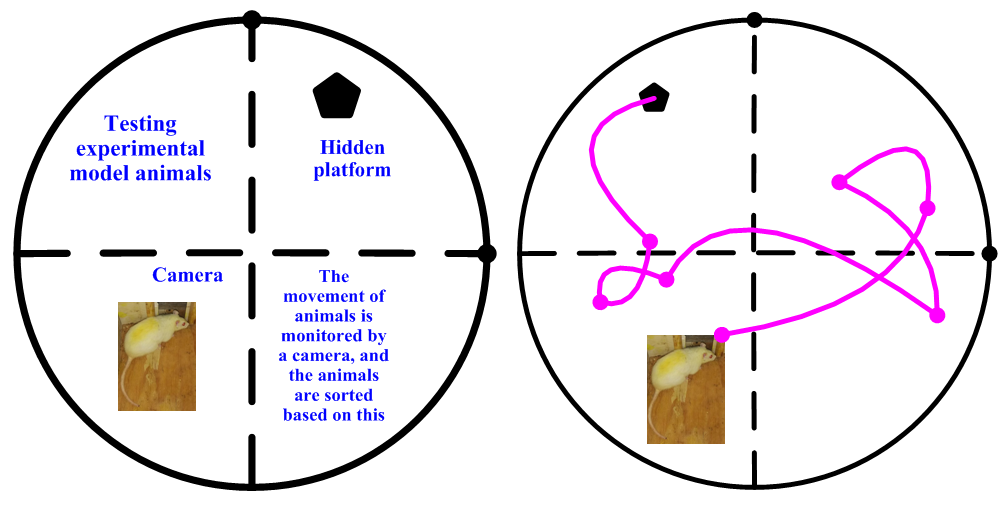 | Figure 1. Scheme of the Morris water maze test |
This research method is conducted for 2-14 days and repeated up to 6 times a day [6,7], as a result of the use of this test, Morris focuses on studying spatial memory and identifying memory impairment in rats with hippocampal dysfunction [8], which is why this test is used to assess operational and long-term memory in animals with experimental Alzheimer's disease (Figure 2).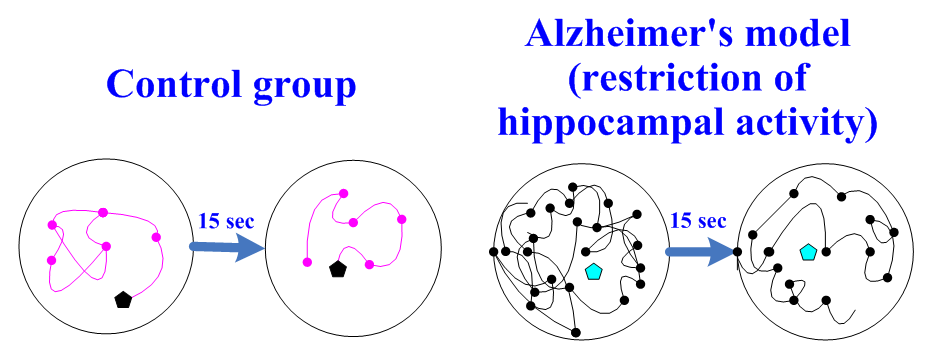 | Figure 2. Behavior after 15 seconds in the Morris water maze test |
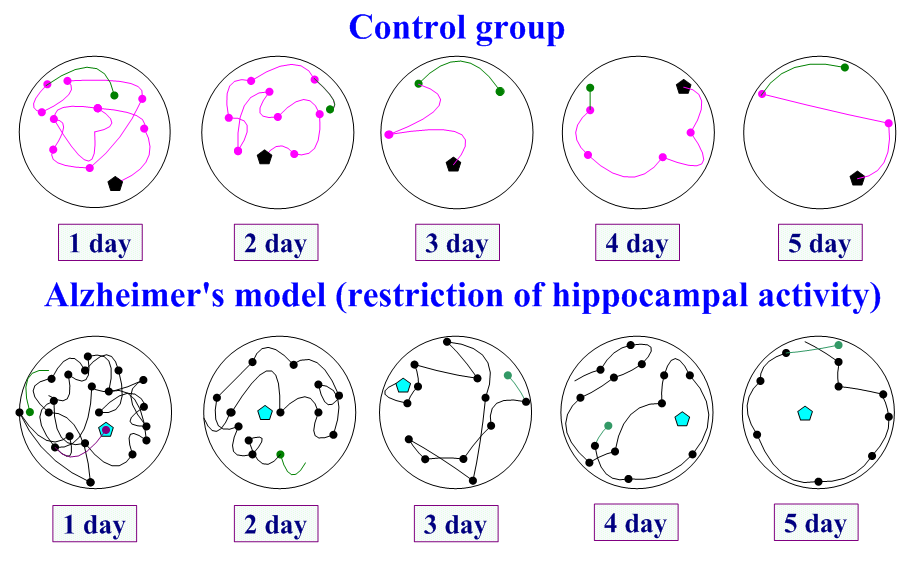 | Figure 3. Samples from the examination tracks of animals challenged with Alzheimer's disease for 5 days in the Morris water maze |
Over time, various variations of this test have emerged, with changes to the test itself. Namely, changes have been made to the number of trials per day and the length of the break between them [5] and the location of the platform [10]. The colors of the water and the lighting conditions have also been changed. In addition, different sizes of pools have been used, but these changes have not been shown to have any significant effect on the test results [11].The most important moment in analyzing the results of the Morris water maze test is the measurement of the time required for this test. However, it is difficult to consider this as an objective criterion for studying spatial knowledge and memory. Since its essence depends on the speed of movement of the animal in the pool [12], therefore, in addition to changing the protocol, additional indicators were also measured during the test. In particular, the time the animal spent in the target square, i.e. the part immediately adjacent to the closed platform, was measured, and the projection of the animal in the pool and its length were also measured [13]. The Morris water maze has long been considered a reliable method for assessing the cognitive functions of experimental animals. The Morris water maze test has also been called an experimental model of Alzheimer's disease, in which liposomal Streptozotocin is injected intranasally. It is used to alter spatial memory in animals. The test was conducted over a 6-day period, platform detection time and track lengths were measured. The data obtained showed that spatial memory was statistically significantly improved in the group of rats administered liposomal streptozotocin [14]. The original radical maze was created before the Morris water maze and was used in 1976 by D.S. Gold and R.J. Samuelsin to study spatial memory in rats [15]. In its original form, it consists of a series of equal-length arms radiating from a circular center. When using an eight-arm radical maze, it allows for a complete study of the neurodegenerative condition. A food container (sweet) is attached to the end of each arm so that it is not visible from the center of the maze. When using this test, it is necessary to develop an optimal protocol in terms of time and labor costs that will allow obtaining reliable and reproducible results. According to one of these protocols, experimental animals were tested for 5 days with a 24-hour break after 4 days of testing. Tests were performed to assess long-term spatial memory. On the 1st day, animals were trained under the test conditions. The test itself was conducted in two stages, each lasting 5 minutes. There was a 30-second break between these stages. During the first stage, 4 sleeves were opened in opposite directions. The remaining 4 sleeves were closed. In the second stage, the previously opened sleeves were closed, isolating the feed at the ends. However, the previously closed ones were left open. | Figure 4. "Sakkiz burchakli radial labirint" |
After the test, the rats' memory scores are calculated according to the following formula. Here, a single entry into the sleeve is considered reliable or correct, and a re-entry into the sleeve is considered unreliable. This protocol requires less time to complete 16 tests and does not require a long testing period, as in the real version [15]. Our experiments conducted on outbred white rats confirm this, and this allowed us to use this protocol in spatial learning and long-term memory assessment in rats (Figure 5) [17].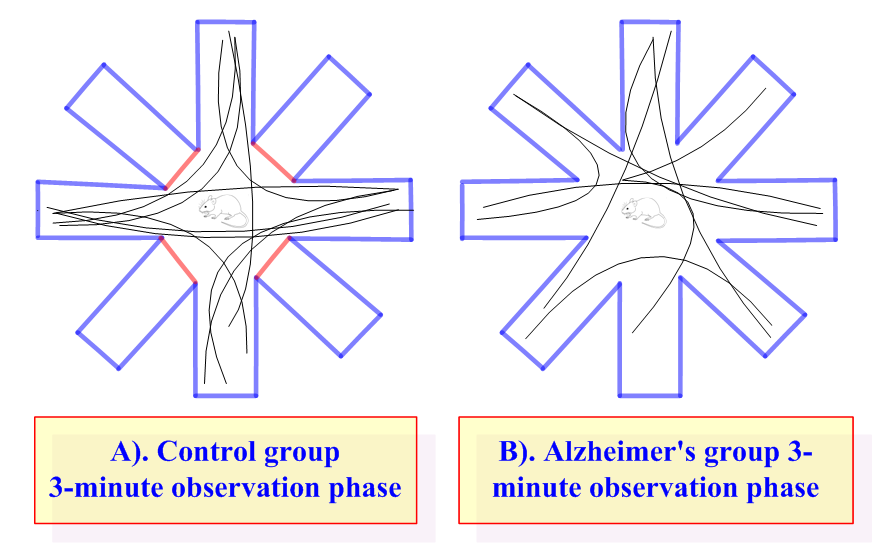 | Figure 5. A). Control group. B). Alzheimer's group. Sample of troections in the eight-arm radical maze test |
In this case, it is assumed that the animals must remember well which sleeve of the maze they were in. Therefore, when evaluating the test results, the animals' re-entry into the sleeve from which they previously entered is considered an error. During the test, the animal can use odor, sound, and light sources as targets to assess spatial learning and memory. To minimize the effect of odor in a sealed food container, a radical water maze was developed using a different number of sleeves.T.M. Ishankhodjaev noted that one of the sleeves serves as a starting point, and the remaining 7 are located at the end of each sleeve, which serve as an exit from the platform. In the first stage of the test, the animal can enter the sleeve it encounters and find one of the 7 evacuated platforms. In the second stage, only 6 sleeves are left with their platforms. T.S. Saatov and his students found that rats have an amazing ability to remember the maze sleeves they entered, that is, when the number of sleeves increased from 8 to 16, then to 24, and finally to 48, the test results did not change [20]. The results obtained indicate that the spatial memory of animals in the experimental neurodegenerative condition Alzheimer's is limited to remembering 24-32 locations at a time [21].Spatial memory in rats can vary significantly when using representatives of different strains of these animals. To determine the most effective dose of streptozocin, the 8-arm maze method was used to assess changes in spatial memory after intranasal administration of this drug to young rats. The drug was administered at a dose of 1 or 3 mg/kg from day 22 to day 59 of the postnatal period of development of the animals, during which time the 8-arm radical maze test was performed daily according to a standard protocol to assess spatial memory. The results obtained allowed us to predict that a dose of 3 ml/kg of streptozocin would have a positive effect only in the early stages of administration. The Morris water maze and the eight-arm radical maze tests have their advantages and disadvantages. The main advantage of the Morris water maze is the absence of discretion (constraint) in the choice of direction by the animals. When passing classical mazes, animals are limited by the available options [13].In the water maze, where a sudden decision is made to choose a direction, the advantage of the maze is the use of water, which prevents the animal from being distracted by odors or any visible signs in the maze. The disadvantage of the Morris water maze is that, unlike rats, mice are not natural swimmers and must be deprived of stimulation in the form of electric shocks or a food source in order to participate in the test [3]. One such study showed that in platform exploration, the difference in time is explained in almost 50% of cases by the variability in the ability of the animals to stand in front of the walls of the pool, which in the results of the test with animals accounts for only 13% of the contribution of spatial memory [20,21].The advantages of the eight-arm radical maze: it takes less time to perform the test, it is more compact, and it is possible to control a greater number of indicators. There are fewer factors that affect the results obtained, and it is easy to work with mice as well as rats. The disadvantage of this method is that it is quite difficult to completely deprive the animal of odors and visual aids in the maze [2,21]. In addition, the complexity of the maze shape and the use of contrast dyes as targets for shadows can cause interruptions and stops in the animal's condition on the video camera. Thus, as a result of analyzing the data obtained from the literature on these two tests, their advantages and disadvantages were separately identified and are listed in Table 1.Table 1. Comparative analysis of Morris water maze and eight-arm radical maze tests
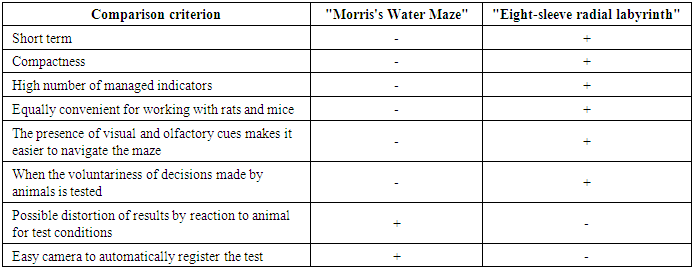 |
| |
|
4. Conclusions
In basic research, it is clear which function of the central nervous system should be assessed when choosing a cognitive test for experimental animals. The most important states that can be modeled in animals are reflexes and memory. When choosing a test based on the purpose of the research, the effectiveness of this test consists of 3 aspects (i.e., type), such as its flexibility (the ability to change certain indicators), objectivity and interpretation, which are important for assessing learning and spatial memory (search and consolidation).
References
| [1] | Ishankhodjaev T. et al. Study on Effects of Liposomal Quercetin on Biochemical Parameters of the Nigrostriatal System of Rats with Experimentally Induced Neurodegenerative Disease // Annals of the Romanian Society for Cell Biology. – 2021. – С. 6128-6143. |
| [2] | Mukhammadjon M. et al. The effect of NGF on indicators of the antioxidant system in rat brain tissue // Universum: химия и биология. – 2021. – №. 9 (87). – С. 82-86. |
| [3] | Saatov T. et al. Antioxidant and hypoglycemic effects of gossitan // Endocrine Abstracts. – Bioscientifica, 2019. – Т. 63. |
| [4] | Saatov T. et al. Study on hypoglycemic effect of polyphenolic compounds isolated from the Euphorbia L. plants growing in Uzbekistan // Endocrine Abstracts. – Bioscientifica, 2020. – Т. 70. |
| [5] | Saatov T. et al. Correction of oxidative stress in experimental diabetes mellitus by means of natural antioxidants // Endocrine Abstracts. – Bioscientifica, 2021. – Т. 73. |
| [6] | Irgasheva S. et al. Study on compositions of lipids in tissues of rats with alimentary obesity // Endocrine Abstracts. – Bioscientifica, 2019. – Т. 63. |
| [7] | Mamadalieva N. I., Mustafakulov M. A., Saatov T. S. The effect of nerve growth factor on indicators of the antioxidant system in rat brain tissue // eurasian union of scientists. series: medical, biological and chemical sciences Uchrediteli: ООО" Logika. – 2021. – №. 11. – p. 36-40. |
| [8] | Saatov T. et al. Study on antioxidant and hypoglycemic effects of natural polyphenols in the experimental diabetes model // Endocrine Abstracts. – Bioscientifica, 2018. – Т. 56. |
| [9] | Mustafakulov M. et al. Determination of antioxidant properties of L-cysteine in the liver of alloxan diabetes model rats // International Journal of Contemporary Scientific and Technical Research. – 2023. – №. Special Issue. – p. 47-54. |
| [10] | Mamadalieva N. I., Mustafakulov M. A., Saatov T. S. The Effect of Nerve Growth Factor on Antioxidant System Indicators in Rat Brain Tissues // Environmental Science. – 2021. – Т. 723. – p. 022021. |
| [11] | Mustafakulov M.A. Plasmid Types and the Importance of Plasmids in Cell Engineering // Best Intellectual Studies // – 2024. – Т. 17. – №. 3. – p. 63-67. |
| [12] | Mallayeva M., Mustafakulov M. // The Effect of Polyphenols on Peroxidation Products of Lipids in Toxic Hepatitis // International Journal of scientific and Applied Research. – 2024. – Т. 1. – №. 3. – p. 75-78. |
| [13] | Mustafakulov M. et al. // Analysis of the Amount of Polyphenols Present in the Morphological Organs of Plants Belonging to the Euphorbiaceae Family // International Journal of scientific and Applied Research. – 2024. – Т. 1. – №. 3. – p. 66-69. |
| [14] | Saatov T. et al. Antioxidant and hypoglycemic effects of gossitan // Endocrine Abstracts. – Bioscientifica, 2019. – Т. 63. |
| [15] | Saatov T. et al. Study on antioxidant and hypoglycemic effects of natural polyphenols in the experimental diabetes model // Endocrine Abstracts. – Bioscientifica, 2018. – Т. 56. |
| [16] | Irgasheva S. et al. Study on compositions of lipids in tissues of rats with alimentary obesity // Endocrine Abstracts. – Bioscientifica, 2019. – Т. 63. |
| [17] | Mustafakulov M. et al. Determination of antioxidant properties of l-cysteine in the liver of alloxan diabetes model rats // International Journal of Contemporary Scientific and Technical Research. – 2023. – №. Special Issue. – С. 47-54. |
| [18] | Mukhtorov A. A. et al. Changes in the dynamics of Ca2+ transport in the brain membrane of rats with Alzheimer's disease and their correction with polyphenols // SGS-Engineering & Sciences. – 2024. – Т. 2. – №. 3. |
| [19] | Saatov T. et al. Assessment of hypoglycemic properties of extracts from some medicinal plants in the experimental diabetes model // Endocrine Abstracts. – Bioscientifica, 2022. – Т. 81. |
| [20] | Khoshimov N. N. et al. Rеgulation and corrеction with thе hеlp of polуphеnols to changе thе dуnamics of transport of Ca2+ NMDA-rеcеptors in thе statе of Alzhеimеr's disеasе // SGS-Engineering & Sciences. – 2024. – Т. 2. – №. 3. |
| [21] | Mukhtorov A. A. et al. Changes in the regulation of Ca2+ signaling in synaptosomes in Alzheimer's disease // SGS-Engineering & Sciences. – 2024. – Т. 2. – №. 3. |








 Abstract
Abstract Reference
Reference Full-Text PDF
Full-Text PDF Full-text HTML
Full-text HTML